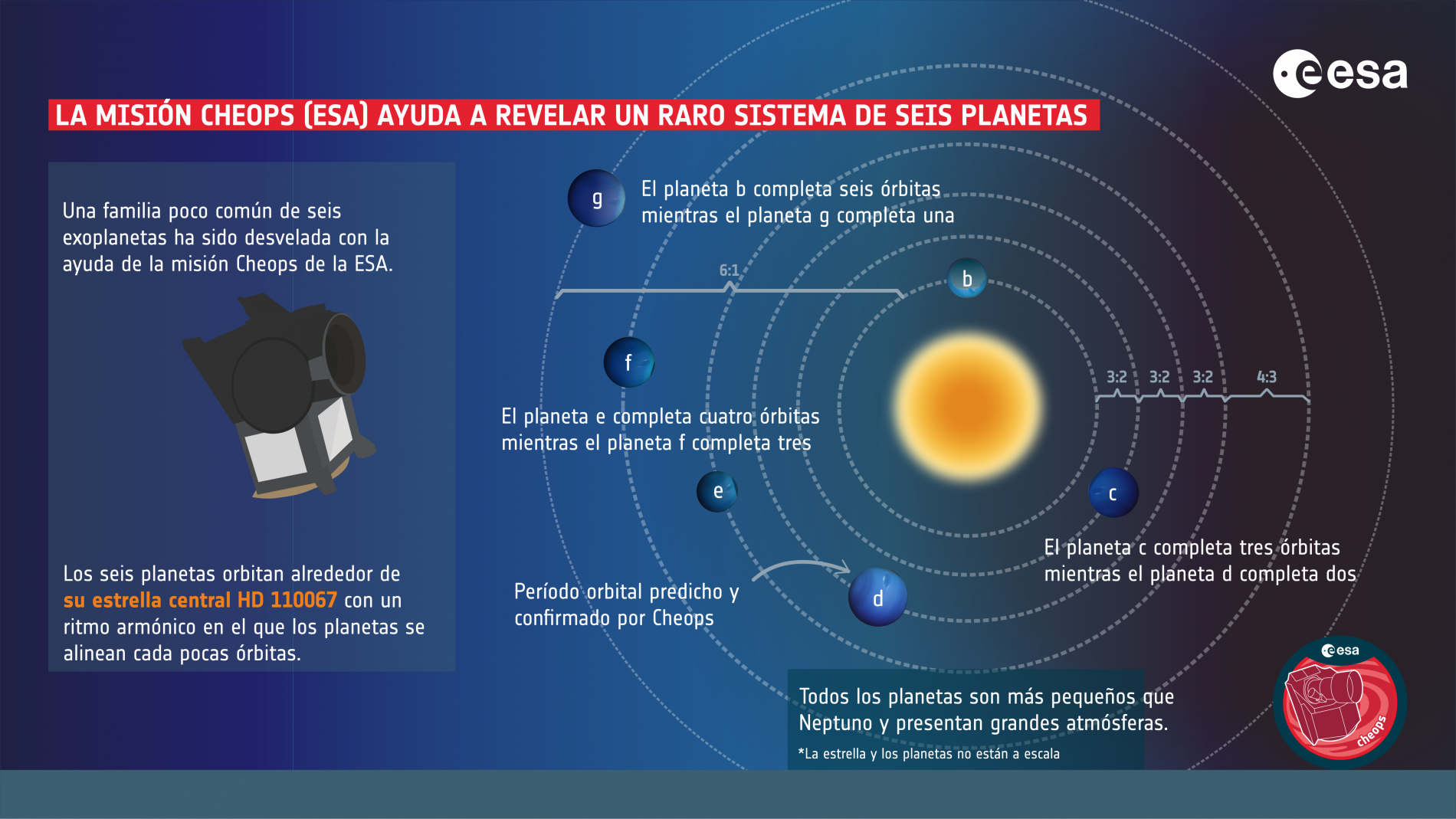A cosmic dance reveals a system of six planets
The Institute of Astrophysics of Andalusia (IAA-CSIC) participates in the discovery of a sixfold system with synchronised orbits, whose configuration shows that it has remained unchanged since its formation more than a billion years ago. The result has been possible thanks to an international collaboration with data from the CHEOPS (ESA) and TESS (NASA) satellites, as well as from the CARMENES instrument at Calar Alto Observatory
An international scientific team, with the participation of the Institute of Astrophysics of Andalusia (IAA-CSIC), publishes today in Nature the discovery of a system of six planets orbiting HD110067, a Sun-like star. It is the brightest known system with more than four planets, which is unique because all its members orbit the star in synchronised orbits, or in resonance, something that is rarely observed and which is an indication that the system maintains the same configuration as when it formed billions of years ago.
The planets in the HD110067 system revolve around the star in a very precise dance: the planet closest to the star completes three orbits around it for every two orbits of the next planet, a so-called 3:2 resonance. This pattern is repeated among the four closest planets, while the planets furthest away have a 4:3 resonance, or four orbits for every three orbits of the next planet. They thus trace a chain of resonances whose constant rhythm allowed the whole system to be revealed.

THE PLANETARY DANCE
In 2020, NASA's TESS satellite detected periodic dips in the brightness of HD110067 that indicated the presence of planets passing in front of the star. A preliminary analysis revealed two possible planets and, two years later, TESS observed the same star again. Analysis of the combined datasets ruled out the original interpretation, but presented two different possible planets. While these detections were more reliable than the original, the data were still inconsistent.
"That's when we decided to use ESA's Cheops: we looked for signals among all the potential periods that these planets could have", says Rafael Luque, a researcher at the University of Chicago who is leading the work.
Their efforts paid off: not only did they confirm a third planet in the system, but they found the key to unlocking the entire system when they found that all three planets were in orbital resonance: the outer planet takes 20.519 days to complete one orbit around the star, which is very close to 1.5 times the orbital period of the next planet, 13.673 days. And this in turn is almost 1.5 times the orbital period of the inner planet, 9.114 days. Predicting other orbital resonances and comparing them with the entire data set allowed the team to discover the other three planets in the system.
THE UNPERTURBED SYSTEM
We know that planets tend to form in resonance, a configuration that can easily be perturbed by, for example, the existence of a very massive planet (such as Jupiter in our Solar System), a close encounter with a star, or an impact. As a result, multi-planetary systems that retain their resonance are rare, and their detection is important because they provide essential information about the formation and subsequent evolution of the planetary system.
"We believe that only about one percent of all systems remain in resonance", says Rafael Luque (U. Chicago). "The HD110067 system is a rarity that shows the pristine configuration of a planetary system that has survived intact”.
"The Universe shows us that our Solar System does not seem to be the norm when it comes to planet formation, and once again gives us an example of the great variety of planetary systems that exist. This one, in addition to its interest in understanding how they form and evolve, may provide us with additional information about why our planetary system is the way it is", concludes Pedro J. Amado, a researcher at the Institute of Astrophysics of Andalusia (IAA-CSIC) who participates in the discovery.
HD110067 is the brightest known system with four or more planets. Since all of these planets are smaller than Neptune and have probably extended atmospheres, it makes them ideal candidates for studying the composition of their atmospheres using NASA/ESA/CSA's James Webb Space Telescope and ESA's future Ariel and PLATO telescopes.
R. Luque et al. “A resonant sextuplet of sub-Neptunes transiting the bright star HD 110067”, Nature, Nov 2023. DOI 10.1038/s41586-023-06692-3
Instituto de Astrofísica de Andalucía (IAA-CSIC)
Unidad de Divulgación y Comunicación
Silbia López de Lacalle - sll[arroba]iaa.es - 958230676
https://www.iaa.csic.es
https://divulgacion.iaa.csic.es

